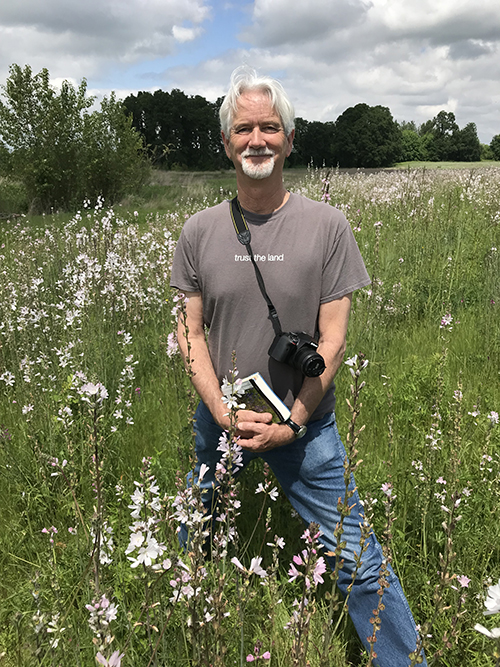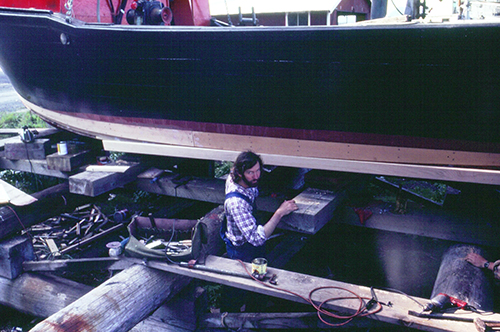
Meet Commissioner Michael Pope. Michael Pope was the Executive Director of the Greenbelt Land Trust, an accredited land trust in the mid-Willamette Valley of Oregon, for 10 years. He has worked for the Oregon Department of Fish and Wildlife as the coordinator of the Oregon Conservation Strategy and managed the agency's wildlife mitigation program. Michael was a faculty research associate at Oregon State University conducting research on black bears, greater sage-grouse, mountain quail and blue and ruffed grouse. He has also worked as a professional boatbuilder and cabinet-maker.
Michael has served on the Commission for three years and was appointed treasurer in 2020.
Q:What drives your passion for land conservation?
A: I have lived in the southeast, northeast and, for the past 43 years, in the Pacific Northwest, an exception to most of my ancestors who migrated little and lived and died in the same communities as their fathers and mothers. Like the vast root networks and canopies of ancient legacy Oregon oaks in Willamette Valley farm fields, my family roots extend deep into the rural black belt soils of Alabama. My grandparents on my mother's side grew peanuts in the warm chalky soils of their southeast Alabama farm. My father's family lived, farmed and prospered in central Alabama and Grandfather Pope was a newspaper editor and local judge who loved hound dogs and quail hunting in the bottomland loblolly pine forests and farm fields in the surrounding countryside. My history is intertwined with the land.
I have had the great privilege of working and traveling in many areas of the Pacific Northwest which has some of the most compelling and diverse natural landscapes in North America. For countless generations the Kalapuya burned the Willamette Valley prairies because they knew that fire was restorative and sustained prairies and savannas that offered a possibility of future foods and fiber for the tribe. They worked to create resources for the future health and well-being of their people. Similarly, the challenge that drives my passion for land conservation is that we have the enormous and absolute responsibility to be the great forecasters of the future of our natural landscapes and work to create a legacy that we can leave for the people, plants and wildlife who will be living along our rivers and in our uplands. The cottonwood, oak, and ash saplings that my local land trust planted this winter in the wet clay river-bottom soils of the Willamette River should be towering forests for future generations.
 Q: Do you find there are any challenges in being the Treasurer for the Commission? What do you enjoy about the role?
Q: Do you find there are any challenges in being the Treasurer for the Commission? What do you enjoy about the role?
A: My role as Treasurer has been relatively easy because the Commission is a very high functioning organization with superlative staff and Commission members. They are also blessed to have strong support from the Land Trust Alliance and land trust community. Perhaps one of the most interesting challenges as Treasurer has been learning more about the inter-relationships between a supporting organization (Commission) and its supported organization (Alliance). What I enjoy most about being the position is the opportunity to interact with Commission and Alliance staff who are highly professional and committed people who care intensely about their work, the profound visons and missions of their organizations, and the wonderful land trusts that they serve.
Q: What has been the most surprising thing about serving on the Commission?
A: The most surprising and intriguing thing about my service as a Commissioner is learning more about the incredible diversity of our land trust world and their interest in addressing some of the most pressing issues within their communities. I am also beginning to understand that the land trust community is blazing many innovative pathways for more cultural diversity in the environmental sector. My work with the Commission has given me a few glimpses into some truly remarkable land trusts who are working with the social service and health care sectors to enhance opportunities for more local food security, equitable and universal access to natural and recreation areas, and to promote a vision of healthy communities on healthy lands.
Q: You were a professional boatbuilder in Washington, Maine, Maryland and Alaska for eleven years. What did you enjoy about this time?
 A: My work as a professional boat builder and shipwright was in many ways satisfying. Historically, boatbuilding design and building had strong relationships to specific regions resulting in an enormous array of different commercial and pleasure boat designs and building techniques. I was given the opportunity to work on some truly unique traditional wooden boats including some that were built in the early 20th century. However, perhaps some of my most fulfilling memories are working in remote canneries in Alaska repairing wooden fishing boats for the upcoming salmon seasons. My work was usually done during early (and still quite cold) Alaska spring days and I often found myself dropping whatever tasks I had at hand to watch a flock of tundra swans fly overhead or observe a recently awakened grizzly bear chase ravens on the cobbly Kodiak Island beaches.
A: My work as a professional boat builder and shipwright was in many ways satisfying. Historically, boatbuilding design and building had strong relationships to specific regions resulting in an enormous array of different commercial and pleasure boat designs and building techniques. I was given the opportunity to work on some truly unique traditional wooden boats including some that were built in the early 20th century. However, perhaps some of my most fulfilling memories are working in remote canneries in Alaska repairing wooden fishing boats for the upcoming salmon seasons. My work was usually done during early (and still quite cold) Alaska spring days and I often found myself dropping whatever tasks I had at hand to watch a flock of tundra swans fly overhead or observe a recently awakened grizzly bear chase ravens on the cobbly Kodiak Island beaches.
Q: What is your favorite way to spend time in nature?
A: Currently some my most favorite ways to spend time in nature is to ramble across the upland and wet prairies and hardwood forests of the Willamette Valley or to lie down during a warm summer day under the canopies of ancient Oregon white oaks and peer up at the profusion of twisted giant limbs that straddle the sky or to paddle my kayak down the Willamette River in the early morning to observe kingfishers flying low across the water or bald eagles perch proudly on the upper reaches of giant floodplain cottonwoods.
Thanks to Michael for sharing his story with us!




